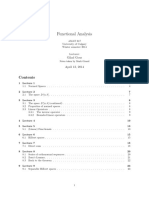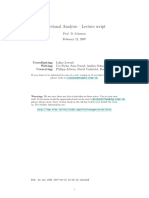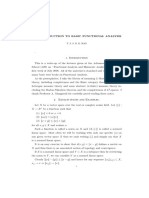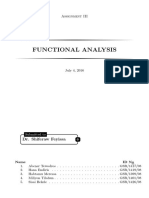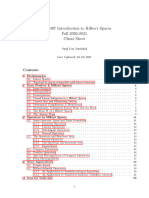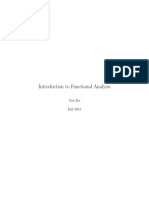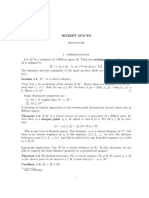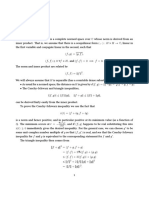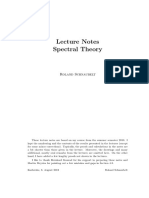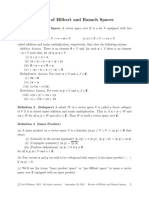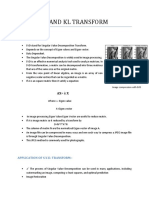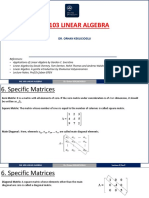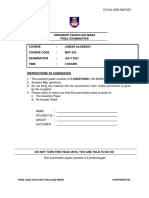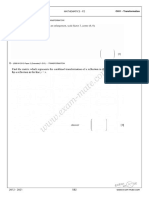1 Hilbert spaces
Definition .1. (Orthogonal projection) Let x ∈ X, Y ⊂ X a linear subspace.
The orthogonal projection of x onto Y is the unique P x ∈ X, if it exists,
such that P x ∈ Y , x − P x ∈ Y ⊥
Theorem .2. Let {e1 , ..., en } orthonormal and Y = Span{e1 , ..., en }, then
• {e1 , ..., en } is a basis of Y and ∀α1 , ..., αn ∈ F:
n
X n
X
∥ αk ek ∥2 = |αk |2
k=1 k=1
• ∀x ∈ X, ∃P x and it is given by
n
X
Px = (x, ek )ek
k=1
•
n
X
2
∥P x∥ = |(x, ek )|2
k=1
Definition .3. (Gram-Schmidt) Let {xn } be linearly independent. Define ẽ1 =
x1 , e1 = ẽ1 /∥ẽ1 ∥, ẽ2 = x2 − (x2 , e1 )e1 , so that generally
k−1
X ẽk
ẽk = xk − (x, ej )ej , ek = ,
j=1
∥ẽk ∥
Then {ek } is orthonormal.
Definition .4. (Hilbert space) An inner product space X, where the norm is
complete is a Hilbert space.
Theorem .5. If X is Hilbert and Y a closed linear subspace, then ∀x ∈ X
∃!P x ∈ Y orthogonal projection.
X Hilbert, Y closed linear subpace =⇒ ∀x ∈ X, ∃!y ∈ Y, z ∈ Y ⊥ : x = y + z (orthogonal decomposition of x w
X Hilbert =⇒ ∀Y ⊂ X closed lin. sub. Y ⊥⊥ = Y =⇒ ∀Y ⊂ X closed lin. sub., Y ⊥ = {0} =⇒ Y = X
Theorem .6. Let Y ⊂ X lin. sub. x ∈ X, then for any z ∈ Y :
x − z ∈ Y ⊥ ⇐⇒ ∥x − z∥ ≤ ∥x − y∥, ∀y ∈ Y.
1
�Lemma .7. (Orthonormal Basis, ONB) X an inner product space is sepera-
ble ⇐⇒ ∃{en } orthonormal such taht X = clSpan{en }. Such a {en } is an
orthonormal basis (ONB) for X.
Lemma .8. X Hilbert {en } orthonormal:
∞
X
∀α ∈ F(N) : α ∈ ℓ2 ⇐⇒ z := α(k)ek converges in X.
k=1
P∞ .9. X Hilbert Y closed lin. sub. Let {en } a ONB for Y , x ∈ X.
Theorem
Then k=1 (x, ek )ek converges and equals the orthogonal projection of x onto
Y:
X∞
Px = (x, ek )ek .
k=1
Lemma .10. X Hilbert, {en } orthonormal. The following are equivalent:
1. clSpan{en } = X
P∞
2. ∀x ∈ X, x = k=1 (x, ek )ek
P∞
3. ∀x ∈ X, ∥x∥2 = k=1 |(x, ek )|2 (Parseval’s identity)
4. {en }⊥ = {0}.
We call {(x, en )} the Fourier coefficients of x ∈ X with respect to the ONB
{en }.
2
�2 Bounded operators
Theorem .11. (Invertibility criterion) T ∈ B(X, Y ), the following are equiva-
lent
• T is invertible
• T is bijective and ∃s > 0 : T B0 (1) ⊇ B0 (s)
• T is surjective, and ∃s > 0 : ∥T x∥ ≥ s∥x∥.
The largest s for which the last two hold is s = ∥T −1 ∥−1 .
Definition .12. X, Y are isomorphic if there exits a T ∈ B(X, Y ) which is
invertible.
If X, Y are isomorphic, then
X complete/ seperable ⇐⇒ Y complete/ seperable.
Lemma .13. If T ∈ L(X, Y ) an isometry, that is ∥T x∥ = ∥x∥, X ̸= 0, then
T ∈ B(X, Y ), ∥T ∥ = 1, ker T = 0.
3
�3 Operators on Banach spaces
Theorem .14. .
If X Banach, R ∈ B(X), ∥R∥ < 1 =⇒ I − R is invertible, and
∞
X
(I − R)−1 = Rk .
k=0
Theorem .15. Banach isomorphism theorem
Let X, Y Banach. If S ∈ B(X, Y ) is a bijection then S is invertible.
Theorem .16. Closed Graph Theorem
X, Y Banach, T ∈ L(X, Y ). If Gr T is a closed subspace of X × Y , then T ∈
B(X, Y ).
Theorem .17. Uniform Boundedness Principle
Let X Banach, Y normed. Let T ⊂ B(X, Y ) such that
∀x ∈ X, ∃cx > 0 : ∀T ∈ T , ∥T x∥ ≤ cx ,
then
∃C > 0 : ∀x ∈ X, ∥T x∥ ≤ C∥x∥.
That is ∃C > 0 : ∥T ∥ ≤ C, ∀T ∈ T .
4
�4 Dual Space
Definition .18. (Dual space) The dual space of X is the normaed space
X ′ = B(X, F).
Definition .19. (Riesz map) If X is an inner product space, then the Riesz
map is R : X → X ′ , y 7→ Ry ∈ X ′ , where (Ry)x = (x, y) ∀x ∈ X.
• anti-linear R(αx + y) = αRx + Ry.
• isometric, ∥Ry∥ = ∥y∥.
Theorem .20. (Riesz-Fréchet) If X is an inner product space the following are
equivalent
• X is Hilbert
• ∀Y ⊂ X closed subspace, Y ⊥⊥ = Y
• ∀Y ⊂ X closed subspace, Y ⊥ = 0 =⇒ Y = X
• R is surjective, thus it is an isometric isomorphism.
Lemma .21. X Hilbert =⇒ X ′ Hilbert with inner product
(f, g) = (R−1 g, R−1 f ), ∀f, g ∈ X ′ .
Lemma .22. (Hölder) If p, q ∈ [1, ∞], p1 + 1q = 1, ∀x ∈ ℓp , ∀y ∈ ℓq , we have
x · y ∈ ℓ1 , and ∥x · y∥1 ≤ ∥x∥p · ∥y∥q ⇐⇒ x, y linearly independent.
Theorem .23. When p1 + 1q = 1 and 1 ≤ p < ∞, the map T : ℓq → (ℓp )′ such
P∞
that T y = gy , where gy x = k=1 x(k)y(k), is an isometric isomorphism.
P∞
Theorem .24. The map T : ℓ1 → (c0 )′ , (T y)x = k=1 x(k)y(k), ∀x ∈ c0 is
an isometric isomorphism.
Definition .25. (Dual operator) For T ∈ B(X, Y ) define the dual operator
T ′ ∈ B(Y ′ , X ′ ) by
∀f ∈ Y ′ , T ′ f = f ◦ T.
It is well defined and ∥T ′ ∥ = ∥T ∥.
Lemma .26. • T isomorphism =⇒ T ′ an isomorphism and (T ′ )−1 =
(T −1 )′
If X, Y Banach the converse holds.
• X, Y isomorphic =⇒ X ′ , Y ′ isomorphic.
Converse not generally true even if X, Y are Banach
• X, Y isom. isom. =⇒ X ′ , Y ′ isom. isom.
Converse not generally true even if X, Y Banach.
5
�5 Hahn-Banach
Theorem .27. (Hahn-Banach for normed spaces X normed Y linear subspace.
∀g ∈ Y ′ , ∃f ∈ X ′ : f y = gy, ∀y ∈ Y and ∥f ∥ = ∥g∥.
Lemma .28. (Corollaries Hahn Banach)
• X normed, Z ⊂ X lin. sub. x ∈ X with dist(x, Z) > 0, then ∃f ∈ X ′
such that
– ∥f ∥ = 1
– Z ⊆ ker f
– f x = dist(x, Z).
• X normed, Z ⊆ X closed lin. sub. with Z ̸= X. Let
Ann Z := {f ∈ X ′ : Z ⊆ ker f },
then \
Z= ker f.
f ∈Ann Z
• – ∀x ∈ X, x ̸= 0 =⇒ ∃f ∈ X ′ : ∥f ∥ = 1, f x = ∥x∥.
– ∀y, z ∈ X, y ̸= z =⇒ ∃f ∈ X ′ , f y ̸= f z.
– ∀x ∈ X, ∥x∥ = maxg∈X ′ ,∥g∥=1 |gx|.
• X ′ seperable =⇒ X seperable
P∞
• T : ℓ1 → (ℓ∞ )′ , (T y)x = k=1 x(k)y(k) is not surjective.
6
�6 weak-* convergence
Definition .29. (Weak-* convergence) {fn } weak-* converges to f ∈ X ′ if {fn }
converges pointwise to f .
Theorem .30. X separable, {fn } ⊆ X ′ be a bounded sequence, then there exists
a subsequence and f ∈ X ′ : fnk →∗ f .
Particularly, closed balls in X ′ are weak-* compact.
7
�7 reflexivity
Definition .31. (Evaluation, second dual X ′′ , reflexive space) Let J : X → X ′′ ,
so that for all x ∈ X, Jx ∈ X ′′ and for all f ∈ X ′ . (Jx)f = f x. We observe
• Jx ∈ B(X ′ , F).
• J : X → X ′′ is an isometry.
A space where J is surjective is called a reflexive space. Then J is an isom.
isom..
Examples are if dim X < ∞, X is Hilbert, X = ℓp for 1 < p < ∞.
X reflexive and separable =⇒ X ′ separable.
Theorem .32.
X not Banach =⇒ X not reflexive.
Theorem .33. c0 , ℓ1 , C 0 [a, b] are not reflexive.
Theorem .34. Y ⊆ X closed lin. sub., then X reflexive =⇒ Y reflexive.
ℓ∞ is not reflexive, as c0 ⊆ ℓ∞ closed lin. sub. and not reflexive.
Theorem .35. • X reflexive =⇒ X ′ reflexive
• X Banach, X ′ reflexive =⇒ X reflexive
8
�8 Weak convergence
Definition .36. (Weak convergence) {xn } ⊂ X is weakly convergent to
x ∈ X if ∀f ∈ X ′ , f xn → f x, write xn ⇀ x.
xn ⇀ x ⇐⇒ Jxn ⇀∗ Jx
Theorem .37. • Weak limits are unique
• – xn → x =⇒ xn ⇀ x. If dim X < ∞ it is ⇐⇒ .
– A ⊆ X weakly sequentially closed =⇒ A is closed.
• Weakly convergent sequences are bounded
• Y ⊆ X lin. sub., then
– ∀{yn } ⊆ Y , y ∈ Y , yn ⇀ y ∈ X ⇐⇒ yn ⇀ y ∈ Y .
– Y closed =⇒ Yweaklysequentiallyclosed.
•
xn → x ⇐⇒ Jxn → Jx =⇒ Jxn ⇀∗ Jx ⇐⇒ xn ⇀ x.
• If X is separable, then closed balls in X ′ are weak-* sequentially compact.
9
�9 Adjoint operators
IN THIS SECTION X IS HILBERT
Theorem .38. (Adjoint operator of T )
T ∈ B(X, Y ) adjoint operator of T is the operator T ∗ : B(Y, X):
∀x ∈ X, ∀y ∈ Y : (T x, y) = (x, T ∗ y).
The following hold
−1 ′
• T ∗ = RX T Ry ∈ B(Y, X)
• ∥T ∗ ∥ = ∥T ∥
• (T ∗ )∗ = T
• ∥T ∗ T ∥ = ∥T ∥2
Example .39. (Multiplication operators in L2 [0, 1])
α ∈ CC0 [0, 1], Tα ∈ B(L2C [0, 1]), (Tα x)(t) = α(t)x(t). Then the adjoint of Tα is
Tα∗ = Tα .
Example .40. (Right and left shift operators on ℓ2 ) If R ∈ B(ℓ2 ) is the right
shift operator, then R∗ = L the left shift operator.
Lemma .41. Let T ∈ B(X, Y ), then
• ker T ∗ = (Im T )⊥
• (ker T ∗ )⊥ = cl(Im T ), thus ker T ∗ = 0 ⇐⇒ cl(Im T ) = Y
Lemma .42. .
T has finite rank ⇐⇒ T ∗ has finite rank:
• m = dim(Im T ) = dim(Im T ∗ ).
• ∃u1 , .., um ∈ X which are linearly independent and v1 , ..., vm ∈ Y such
that
Xm m
X
Tx = (x, uk )vk , T ∗ y = (y, vk )uk
k=1 k=1
Lemma .43. .
If T ∈ B(X, Y ), then
ker T ∗ = 0 and ∃D > 0 : ∥T x∥ ≥ D∥x∥, ∀x ∈ X ⇐⇒ T is invertible.
10
�10 normal, self adjoint, unitary operators
IN THIS SECTION X IS HILBERT
Definition .44. (Normal, Self-adjoint, Unitary operators)
T ∈ B(X):
• normal if T ∗ T = T T ∗
• self-adjoint if T ∗ = T
• unitary if T ∗ T = I = T ∗ T .
Theorem .45. (Invertibility of normal operators)
T ∈ B(X) normal, then
T invertible ⇐⇒ ∃D > 0 : ∀x ∈ X, ∥T x∥ ≥ ∥x∥
11
�11 invariant subspaces
Definition .46. (T-invariance)
T ∈ B(X), a subspace Y ⊆ X is T -invariant if T Y ⊆ Y . Denote the restriction
of T to Y as
TYY : Y → Y.
12
�12 spectrum of an operator
IN THIS SECTION X IS HILBERT
Definition .47. (Eigenvector, eigenvalue)
λ ∈ F is an eigenvalue of T if there exists an eigenvector xλ ∈ X:
T xλ = λxλ .
The λ−eigenspace of T is denote by Eλ = ker(T −λI). The set of λ−eigenvectors
is Eλ \ {0}.
Lemma .48. .
Let λ1 , ...λn be distinct eigenvalues, and let xk ∈ Eλl \ {0} for 1 ≤ k ≤ n.
Then x1 , ..., xn are linearly independent.
Definition .49. (point spectrum, spectrum, spectral radius, numerical range,
numcerical radius)
• Point spectrum of T : σp (T ) = {λ ∈ F : T − λI not injective = {λ ∈ F :
Eλ ̸= 0}, so it contains all eigenvalues of T .
• Spectrum of T : σ(T ) = {λ ∈ F : T − λI is not invertible} ⊇ σp (T )
• Spectral radius of T
• Numerical range of T : V (T ) = {(T x, x) : ∥x∥ = 1}
• Numerical radius of T : rV (t) = sup{|µ| : µ ∈ V (T )}.
Lemma .50. .
T ∈ B(X)
• X = {0} =⇒ σ(T ) = ∅
• σp (T ) ⊆ V (T )
• rV (T ) ≤ ∥T ∥
• If |λ| > ∥T ∥, then λ ∈
/ σ(T )
• σ(T ) is closed.
Lemma .51. .
If T ∈ B(X), then rσ (T ) ≤ ∥T ∥ and σ(T ) ⊆ F is compact.
Lemma .52. .
• σ(µI) = {µ}, σ(νT + µI) = νσ(T ) + µ
• σ(T ∗ ) = {λ : λ ∈ σ(T )}
13
� • ...
Lemma .53. (spcetral properties self-adjoint operators) Let S ∈ B(X) be self-
adjoint, then
• V (S) ⊆ R.
• σp (T ) ⊆ R
• ∀µ, λ ∈ σp (S), λ ̸= µ =⇒ Eλ ⊥ Eµ .
Theorem .54. (Baby Spectral Theorem)
Let X ̸= 0, S ∈ B(X) self-adjoint. Then
• σ(S) ⊆ cl(V (S)) ⊆ R.
• at least one of ∥S∥ and −∥S∥ is in σ(S)
• rσ (S) = rV (S) = ∥S∥.
• (min σ(S), max σ(S)) ⊆ V (S) ⊆ [min σ(S), max σ(S)]
Lemma .55. .
If X ̸= 0, S ∈ B(X) self adjoint, then
• σ(S) ̸= ∅
• σ(S) = {0} ⇐⇒ S = 0.
14
�13 compact operator Banach spaces
15
�14 compact operator on Hilbert spaces
16
�15 Spectral properties compact operators
17
�16 Spectral properties compact self-adjoint op-
erators
Theorem .56. (Spectral Theorem) Let T ∈ B(X) be compact and self-adjoint.
Let for N ∈ N ∪ {∞} {λn }N n=1 = σp (T ) \ {0} (λ ∈ σp (T ) \ {0} appears with
multiplicity nλ (T ) = dim Eλ ).
⊥
Then there exists an ONB {en }N n=1 of (ker T ) such that en is an eigenvector
of λn ∀n. Thus
XN
∀x ∈ X : T x = λn (x, en )en
n=1
18




